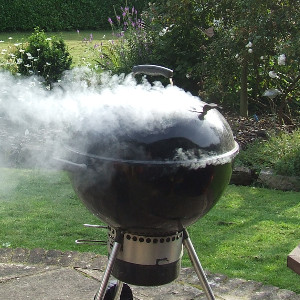The end of May is traditionally the beginning of Grilling Season, with the Victoria Day holiday in Canada and Memorial Day in the U.S. What better time to review a recent study that shows up a heretofore unsuspected danger of cooking over a fire? Hint: Always stand upwind of your grill!
 Stay upstream of the smoke from your grill or smoker, and place the cooker
Stay upstream of the smoke from your grill or smoker, and place the cooker
a respectable distance from your dining spot!
You knew that BBQ smoke and the yummy, savoury compounds grilling creates in your fave summer foods contain carcinogens, potential cancer-causing substances. The upshot of that discovery was a recommendation to grill foods only to the medium-done stage, to minimize the formation of chars that are heavy in carcinogens. We also know enough, instinctively, to stand out of the smoke stream from grills and fire pits.
But, now, in a study appearing in Environmental Science & Technology, scientists report that skin is a more important pathway for uptake of cancer-causing compounds produced during barbecuing than inhalation. They also found that clothing cannot fully protect individuals from this exposure.
It’s everywhere!
In the U.S., 70 percent of adults own a grill or a smoker, and more than half of them grill at least four times a month, according to the National Barbecue and Grilling Industry Association. But barbecuing produces large amounts of polycyclic aromatic hydrocarbons, or PAHs. These carcinogenic compounds can cause respiratory diseases and DNA mutations.
Eating grilled foods is the most common source of PAHs arising from barbecuing. However, according to a previous study by Eddy Y. Zeng and colleagues, bystanders near barbecues were likely exposed to considerable amount of PAHs through skin exposure and inhalation, even if they didn’t eat the grilled foods. Building on that study, the team sought to more precisely quantify skin uptake of PAHs from barbecue fumes and particles.
What they did and what they found…
The researchers divided volunteers into groups at an outdoor barbecue to provide them with varying degrees of exposure to the food and the smoke. After analyzing urine samples from the volunteers, the researchers concluded that, as expected, diet accounted for the largest amount of PAH exposure. However, the skin was the second-highest exposure route, followed by inhalation. They say oils in barbecue fumes likely enhance skin uptake of PAHs.
The team also found that while clothes may reduce skin exposure to PAHs over the short term, once clothing is saturated with barbecue smoke, the skin can take in considerable amounts of PAHs from them. They suggest changing clothes as soon as possible after leaving a grilling area to reduce exposure.
Now you know…
Enjoy grilling this season, but – as I said at the outset – stand upwind of the smoke!
~ Maggie J.

